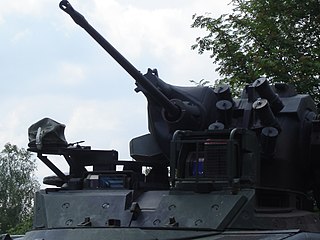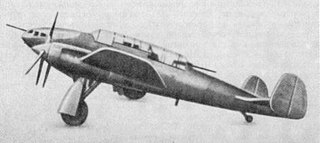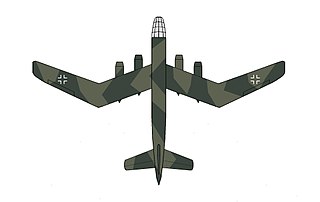Related Research Articles

The Junkers Ju 188 was a German Luftwaffe high-performance medium bomber built during World War II, the planned follow-up to the Ju 88 with better performance and payload. It was produced only in limited numbers, due both to the presence of improved versions of the Ju 88, as well as the increasingly effective Allied strategic bombing campaign against German industry and the resulting focus on fighter production.

Schräge Musik, which may also be spelled Schraege Musik, was a common name for the fitting of an upward-firing autocannon or machine gun, to an interceptor aircraft, such as a night fighter. The term was introduced by the German Luftwaffe during World War II. "Schräge Musik" was previously a German colloquialism, meaning music that featured an unusual tuning and/or time signature. By itself, the word Schräge has often been translated as "slanting" or "oblique", although it may instead be rendered into English as "weird" or "strange".

The Arado Ar 240 was a German twin-engine, multi-role heavy fighter aircraft, developed for the Luftwaffe during World War II by Arado Flugzeugwerke. Its first flight was in 1940, but problems with the design hampered development, and it remained only marginally stable throughout the prototype phase. The project was eventually cancelled, with the existing airframes used for a variety of test purposes.

The Heinkel He 177 Greif (Griffin) was a long-range heavy bomber flown by the Luftwaffe during World War II. The introduction of the He 177 to combat operations was significantly delayed, by both problems with the development of its engines, and frequent changes to its intended role. Nevertheless, it was the only long-range, heavy bomber to become operational with the Luftwaffe during the war. The He 177 had a payload/range capability similar to that of four-engined heavy bombers used by the Allies in the European theatre.

The Blohm & Voss BV 138Seedrache, but nicknamed Der Fliegende Holzschuh was a World War II German trimotor flying boat that served as the Luftwaffe's main seaborne long-range maritime patrol and naval reconnaissance aircraft.

The Focke-Wulf Fw 191 was a prototype German bomber of World War II, as the Focke-Wulf firm's entry for the Bomber B advanced medium bomber design competition. Two versions were intended to be produced, a twin-engine version using the Junkers Jumo 222 engine and a four-engine variant which was to have used the smaller Daimler-Benz DB 605 engine. The project was eventually abandoned due to technical difficulties with the engines.

A gun turret is a mounting platform from which weapons can be fired that affords protection, visibility and ability to turn and aim. A modern gun turret is generally a rotatable weapon mount that houses the crew or mechanism of a projectile-firing weapon and at the same time lets the weapon be aimed and fired in some degree of azimuth and elevation.

The Short S.45 Seaford was a 1940s flying boat, designed as a long range maritime patrol bomber for RAF Coastal Command. It was developed from the Short S.25 Sunderland, and initially ordered as "Sunderland Mark IV".

A tail gunner or rear gunner is a crewman on a military aircraft who functions as a gunner defending against enemy fighter attacks from the rear, or "tail", of the plane.

The Vickers Virginia was a biplane heavy bomber of the British Royal Air Force, developed from the Vickers Vimy.

The Rheinmetall Mk 20 RH-202 is a 20 mm caliber autocannon designed and produced by Rheinmetall. It fires the 20×139mm ammunition originally developed for the Hispano-Suiza HS.820.
The PZL.48 Lampart (leopard) was a Polish heavy fighter-bomber design, that remained only a project, owing to the outbreak of World War II.

The SNCASE SE.100 was a French two-seat, twin-engined fighter which first flew in 1939. Mass production was planned to begin late in 1940 but the Fall of France prevented this.

The Polikarpov VIT-1 was a Soviet twin-engined multi-purpose aircraft developed before World War II. One prototype was built in 1937, with an extremely heavy armament for ground attack duties. That was the only example built as it was decided to revise the design with more powerful engines as the VIT-2.

The Polikarpov VIT-2 was a Soviet twin-engined ground attack aircraft developed before World War II. A single prototype was built in 1938 for evaluation purposes. Although a promising design it was recommended that it be introduced into production as a high-speed dive bomber with a reduced armament to increase its speed.
The Tupolev ANT-21 was a Soviet twin-engined four-seat heavy fighter, which also had the designation MI-3. It was not accepted for production, only two prototypes being built.

The Arado Ar E.340 was a twin-engined dive- and tactical-medium bomber, designed by Arado Flugzeugwerke at the request of the Reich Air Ministry in 1939 to compete for a production contract for the Bomber B fast bomber design competition, but the project was cancelled.

The Arado E.560 was a series of multi-engined Arado medium-range tactical bombers projected during the Second World War.

The Blohm & Voss Bv P 188 was a long-range, heavy jet bomber design project by the Blohm & Voss aircraft manufacturing division during the last years of the Third Reich. It featured a novel W-wing planform with variable incidence.
The Blohm & Voss P215 was an advanced jet night fighter project by Blohm & Voss during the Second World War. With a crew of three and twin jet engines, it featured a tailless swept-wing layout and heavy armament. An order for three prototypes was received just weeks before the war ended.
References
- ↑ Jörg Armin Kranzhoff (1997). "Arado+E.500"&dq="Arado+E.500" Arado: History of an Aircraft Company. Schiffer Book for Collectors. pp. 105, 107. ISBN 9780764302930.
- ↑ Jean-Denis G.G. Lepage (2009), Aircraft of the Luftwaffe, 1935–1945: An Illustrated Guide, Koblenz: McFarland, ISBN 978-0-7864-5280-4